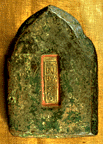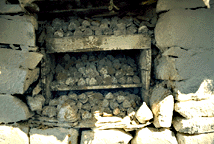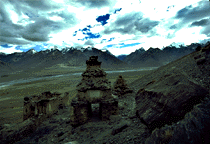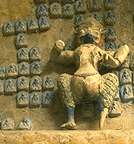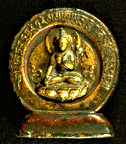 |
In 1938 after returning from one of his extensive expeditions to Ladakh and Western Tibet, the great Italian tibetologist Giuseppe Tucci published a volume on Stupa symbolism as part of the Indo-Tibetica series. The second part of this pioneering study is dedicated to the votive clay tablets known as tsa-tsa (fig.1, left). Although Tucci was not the first to write about tsa-tsa, his study remains the only extensive exploration of this art form. The present article aims at updating some the information on this neglected area of studies.
Any traveller who ventures today into a remote area where Buddhism is practiced in the Himalayas, Ladakh or Tibet is certain to come across examples of clay tablets deposited within stupas, holy caves, and monastery altars. These clay tablets are generally known as tsa-tsa; a name which Tucci traces back to Sanskrit.
The Sanskrit root of the name points to India as the probable country of origin of tsa-tsa. Well known in Indian Buddhist monasteries, the ancestors of clay medallions, however, may go back to the Middle East and represent a survival of an extremely ancient practice going back perhaps several thousand years.
Tsa-tsa are clay impressions made with a metal mould containing the hollowed, reversed image of a deity or sacred symbol. The stamped images are dried in the sun and in some cases fired into hardness (fig. 2, right).
Especially large tsa-tsa are sometimes colored and varnished and may be empowered by inserting a roll of prayers or mantras in a hollow space at the base. They may be empowered also by printing or writing a mantra on the back (fig. 3, left). Thereafter the tsa-tsa is treated no differently from other sacred images. Through auspicious action ordinary clay becomes transformed into a receptacle for sacred power.Tsa-tsa are sometimes produced in connection with a pilgrimage to sacred places. A traveller carries the metal mould and, upon reaching a sacred site, collects holy clay to stamp images. Reciting mantras all the time as the clay is kneaded, a number of tsa-tsa would be produced to either leave behind as offerings or bring back home as relics.
The production of tsa-tsa is considered a meritorious action which generates an abundant dose of auspiciousness for the creator, his family and the immediate area where the work takes place. Sometimes a pilgrim stays in a place for weeks or months pressing an auspicious number of images. These images are then deposited as offerings on the ledges of a stupa, inside stupa gates, within a holy cave, on prayer wheel niches in the ambulation path of a monastery, or in the hollows of the stone walls carved with prayers lining the route.
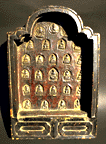 Tsa-tsa produced with sacred clay are also carried home as most precious
relics. These are either placed on the home or monastery altar or given
away as pilgrimage gifts connecting the recipient with the distant sacred
sites. Sometimes pilgrims, after years of following the sacred routes,
accumulate a good number of small tsa-tsa from all the places visited.
In order to preserve them well the small clay medallions are imbedded
in a wood board and a portable altar made out of them (fig. 4, right).
Tsa-tsa produced with sacred clay are also carried home as most precious
relics. These are either placed on the home or monastery altar or given
away as pilgrimage gifts connecting the recipient with the distant sacred
sites. Sometimes pilgrims, after years of following the sacred routes,
accumulate a good number of small tsa-tsa from all the places visited.
In order to preserve them well the small clay medallions are imbedded
in a wood board and a portable altar made out of them (fig. 4, right).
Anything which carries a representation of a deity is considered a sacred object, specially if it has been ritually empowered by a great teacher or came from a holy place. So tsa-tsa are sometimes placed within statues as part of the empowerment. (1)
Tsa-tsa are also pressed on certain special occasions when an important person visits a great lama. Special clays are utilized and sometimes empowered colored powders or ashes from a departed teacher added. When the clay is freshly stamped into the mould and still soft, the lama presses on the back his finger or palm prints. This is usually done as a mantra is recited and a strong positive wish generated into the clay. After the clay dries such tsa-tsa are usually fired to make them stone hard. They are then treated as an amulet and placed either inside a travelling shrine (Tib, Gau) or on the home altar. Such mementos of a visit become prized objects of power, imbued with the positive qualities of the lama who gave it. There are precious tsa-tsa pressed by the high lamas or famous yogis that have been passed down within families as most precious heirlooms.
Amulet tsa-tsa are reverentially touched to the forehead as a blessing when someone is ill or departing for some dangerous enterprise. This a way of imbuing the recipient with the purifying power of the depicted deity or the power of the lama who made it.
Tsa-tsa also play a very important role in funeral practices. Usually after a person passes away a ceremony is performed for 49 days or less in front of an effigy of the deceased. The effigy may be as simple as a woodblock print together with some personal item. A lama reads everyday from sacred texts guiding the consciousness of the departed through the itinerary of the intermediate dimensions called the Bardo. At the conclusion of the readings the paper print representing the deceased is burned in a final ceremony. The ashes from the print are then mixed with clay and a number of tsa-tsa stamped by a relative or close friend. These funeral tsa-tsa are almost always shaped as conical stupas of a very ancient design (2). While the clay is still soft inside the metal mould a few grains of either barley or wheat are inserted. Since funeral tsa-tsa are rarely fired, the grains sometimes sprout bringing to life the tiny stupas. This is a way of symbolically expressing the ceaseless cycle of transformation experienced by all beings.
Funeral tsa-tsa were traditionally deposited inside the open stupa gates lining the approaches to a monastery or left under the ledges of a sacred site (fig. 5, left). Such funeral tsa-tsa by virtue of their sacred shape are treated with respect, and unless they come from the remains of a great teacher, are not kept at home.
The tsa-tsa from the ashes of a great teacher are usually distributed among disciples and followers. They are treated not so much as funeral objects but as tokens of transcendence and the impermanent nature of existence. Instead of inducing feelings of sadness they are instruments for experiencing the luminous quality of infinite space without boundaries.
A very important use of tsa-tsa is in the empowerment of stupas (fig. 6, right). Generally stupas are built as receptacles to enshrine relics of great teachers, sacred books, or anything radiating sacred power; they function as reminders of the liberated state. One of the easiest ways of filling a large stupa with sacred objects is through the production of tsa-tsa. The sponsor for the construction of a stupa hires a team of workers to press thousands of tsa-tsa. This is always messy work where everyone gets covered with mud from head to toe. However, being an auspicious action for everyone involved, a great air of cheerfulness pervades the work. There is rhythmic recitation of prayers or singing of work songs to dissipate fatigue and keep the mind in a cheerful state free of tension. To speed the project several different metal moulds are used with the result that the stupa at the end contain a great assortment of images. This type of work is usually done at the end of summer, when there is no further work in the fields and the temperature is not yet freezing.
As the tsa-tsa dry they are placed in piles within the core of the open stupa. Once the stupa is full the door of access is sealed up and a lama may then perform a consecration ceremony. In the area of Shey Gompa very near Leh in Ladakh is a vast field of stupas made of unfired clay bricks. With the passage of the centuries some have collapsed, revealing hollow cores several feet high completely packed with unfired tsa-tsa. Such tsa-tsa were usually smeared with white clay paint as a means of general blessing and empowerment.
Monastery walls sometimes are "tiled" with tsa-tsa playing a decorative role similar to wall paintings (fig. 7, left). These tsa-tsa are usually fired and painted. As the centuries pass, inevitably the tsa-tsa fall down and break. Since broken images are not kept within monastery walls, they are placed within special structures where discarded sacred objects are placed.
The use of tsa-tsa is not confined to areas of Tibetan influence only. In southeast Asian countries such as Thailand and Burma tsa-tsa are extremely valued as amulets and often worn around the neck. Around the Wat Po in Bangkok there are several blocks of tsa-tsa amulet sellers sometimes asking extraordinary sums for amulets produced by famous teachers.
In Beijing, at the Hall of Auspicious Clouds in the Qing Palace a complete room is filled with thousands of large tsa-tsa arranged in shelves and altars all around. Each has been carefully painted and empowered.
In the ruins of Khara-Khoto, Dunhuang and Ch'ien Fo-Tung in Central Asia the explorations of Sir Aurel Stein brought to light numerous examples of tsa-tsa, some dating to the eight century.
At this point in our knowledge it is impossible to establish how old is the tradition of pressing clay figures out of molds. In Eastern India tsa-tsa dating from the 8th century have been found in Buddhist ruins (3). It appears that the custom of making tsa-tsa was primarily confined to the Buddhists and did not become an important part of Hindu practices. However in the ruins of Mohenjo-daro, dating from 2500 BC, stone seals have been found which were clearly intended to press upon a soft medium for making impressions. The subjects of these seals are usually deities and sacred symbols that are still little understood.
The Mohenjo daro seals may well be the ancestors of stamps in the Indian subcontinent but in turn they are the eastern representatives of a stamping tradition which began in the Middle East as far back as the 6th millennium BC.(4).
In the ancient Middle East consignments of goods were marked with stamps pressed upon soft clay. These seals seem to have been marks of ownership and by extension protection of the cargo. The symbols used on the seals evolved over the millennia from abstract geometric patterns into mythological figures and deities.
The protective quality of the seals placed them in the category of amulets. In addition the owner of the sealed cargo was also protected by the power communicated by the stamped symbol. As the use of written documents became more widespread they also began to be stamped with seals of authority. If the documents had to be sent far away they were also stamped outside with special seals. Little by little stamping and sealing became associated with power and authority. Large number of middle eastern seals and stamped clay tablets have been recovered from ruins dating as far back as the 6th millennium BC. This practice was not confined to Sumeria and Babylonia but spread to Egypt, Persia, India and probably China, where seals and stamps became extremely important in all official transactions.
Perhaps the tsa-tsa of the Buddhist in the Indian and Tibetan sphere of influence are the descendants of such middle eastern ancestors. It is too early to say.
Reproduction through a repeatable medium occupies a very special place in Tibetan culture. Early on it became associated with meritorious action. Early this century travellers to Tibet reported seeing pilgrims seated by the side of streams stamping the waters with metal tsa-tsa molds, impressing into the flowing waters sacred forms for the benefit of all beings coming in contact with such waters.
During a recent visit to Tibet it was comforting to see in the old streets of Lhasa a travelling merchant offering for sale large numbers of shiny newly made tsa-tsa molds. Thus, despite all of the upheavals Tibetan culture has endured in the recent past, the ancient tradition continues, lending support to the finest aspirations of the human spirit.

